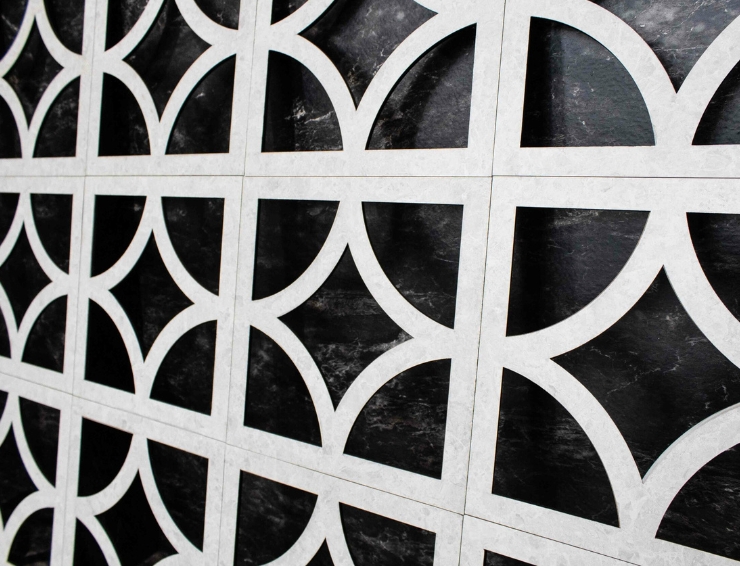Welcoming visitors Tuesday – Sunday, 10AM – 4PM. Admission by donation.

Nonsuch employs commercially printed materials – mesh banners and Formica – to discuss the logic of North American built environments, history and imagined histories.
Please join us for an Exhibition Reception for Nonsuch and Malcolm Mooney & Doyle Lane: Kewanee Street, curated by u’s on April 13, 2024, between 1 and 4 pm. Remarks will be held at 2 pm.
Artist statement:
In 2015, while I was working as a weed-puller for the City of Edmonton, the winding routes between parks and boulevards led me to many disused and incongruous pockets of the city. One particularly strange pocket, in the Griesbach neighbourhood in Edmonton’s Northwest quadrant, was located on a street called Nonsuch. Here, piles of discarded structural remains sat abandoned, broken breezeblocks balancing on slabs of reinforced concrete. Nearby, an orderly line of streetlights remained perfectly upright. This stretch of street, the location of a demolished military barracks awaiting redevelopment, is the basis of this exhibition.
Guidelines for the current Greisbach development dictate that new structures must adhere to five historical building styles, each a disparate reference to architectural movements distinctive of the British Empire: Victorian, Tudor, Colonial, Craftsman and Prairie. The guidelines are an effort to maintain the “historic” authenticity of the former military base, CFB Griesbach, established in 1950. Ironically, these stylistic references, which span the fifteenth century to the early twentieth century, represent an Edmonton that never existed.
One material indicator of urban development is the presence of construction fences and advertising on mesh banners. Employing this visual language, the exhibition blurs the lines between print and sculpture, and between fine art printmaking and commercial production. Images of Nonsuch street appear on this translucent material, where conflicting images interlace and form one confusing mass. This complexity mirrors the neighbourhood’s own paradoxical mingling of mid-twentieth century ruins with new structures modelled loosely on anachronistic inspirations. A breezeblock garden fence made from Formica (a countertop material which imitates stone and wood), another “printed matter” from the world of architecture, creates the illusion of grandeur and substance, which is then deconstructed into a pile of rubble imitating the ones on Nonsuch street.
Compounding the oddity of the young ruins, now replaced with new “old” buildings, was that street name which seemed, to me, to sum it all up: Nonsuch. Nonsuch was the name for a British palace, a variety of naval ships, and Edmonton’s own naval reserve. It was also the name of the ship that made the inaugural trading voyage into Hudson Bay in 1668 for what would become Hudson’s Bay Company. Though the word’s official definition is “unparalleled”, the rhetorical weight of its historical usage for the apparatuses of British imperialism weighs far more heavily. To me, this word operates as a Trojan horse, sounding like an unassuming negation of itself with the prefix “non,” yet recalling residual references to power and Empire that span four centuries. The name is reminiscent, too, of Marc Augé’s concept of “non-place”, a term he uses to describe an alienation from place in the modern world: “Certain places exist only through the words that evoke them, and in this sense they are non-places, or rather, imaginary place: banal utopias, clichés. …Here the word does not create a gap between everyday functionality and lost myth: it creates the image, produces the myth and at the same stroke makes it work…”
That the City of Edmonton is developing this falsely historic neighborhood, its name glamorizing an imperialistic and colonizing past, is not surprising; it is a city concerned with fantasy spaces such as West Edmonton Mall, which boasts a replica of Christopher Columbus’s Santa Maria ship, and attractions like Fort Edmonton Park, staffed by costumed actors, where visitors can re-enact fictionalized versions of history. Augé’s “non-place” is often applied to postmodern commercial spaces like malls, theme parks and airports, since these are defined by advertising, a pervasive feeling of anonymity, and a sense of being unable to place oneself in space and time. Nonsuch is a meditation on the character of Edmonton as exemplified in this street in ruin and development, and more generally North America’s relationship to place, history and fantasy.
Nonsuch is presented by Leighton Art Centre with funding assistance from Government of Canada Department of Canadian Heritage, Alberta Foundation for the Arts, and Calgary Arts Development.
